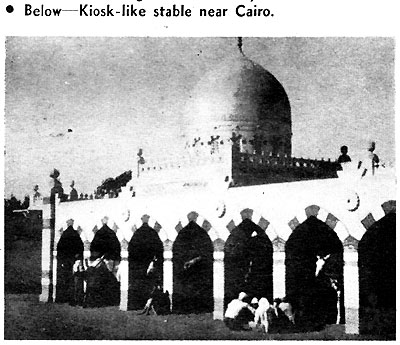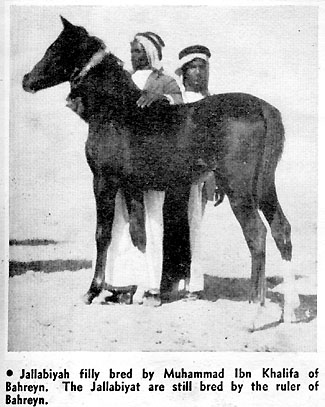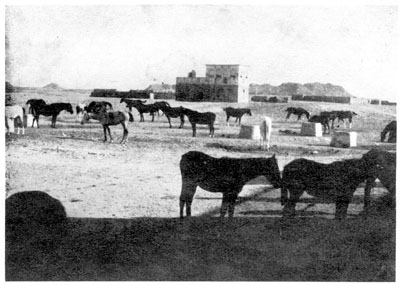| Magnificent celebrations were prepared for the festival of reconciliation
between "the two Feysuls"- both renowned as horsemen and breeders
of the pure strains. Their meeting became the occasion of a reunion of
all the great horsebreeders, horse thieves and horse lovers of Arabia.
A month of truce was proclaimed; the nomadic people of the desert were
to abstain from all hostilities and raids. Owners of the finest and rarest
strains and bloodlines arrived in Riadh. Some were alone, humble and poor,
while others came with slaves an and entourage, exhibiting their wealth
and authority as chieftains. High and low, rich and poor, all were noble
born and freemen, aristocrats of the desert, though some of them had nothing
to boast about but the possession of one great war mare.
Prince Faisal of Arabia asked his guests to assemble their horses
in the "Paradise-Pastures" (as they were called) of Sulaymiyah,
in the Al-Kharj, a few leagues south of the capital of Riyadh.

Among the illustrious visitors none was greater than Srur, Feysul's
former slave. The venerable old Negro was considered one of the real great
men of Arabia. Ibrahim Pasha of Egypt had freed him in Cairo in 1816, on
the day when the Jallabiyah mare had been killed under "little Abbas."
After that tragic incident Srur had served as commander of Ibrahim Pasha's
cavalry in Arabia, and as stud manager and Master-of-Horses in Hejaz (the
coastal province, the Holy Land of Arabia). At the end of 1819, when Ibrahim
Pasha returned from Arabia to Egypt, he offered Srur an even higher position
in Cairo and a palace on the Nile, but the faithful old Negro asked only
to be returned to his master in the desert and became a slave once more.
Thus we find Feysul's old slave in the 1842 at the "riders and
horse-thieves" festival in the "heavenly pastures" of Al
Kharj, once more playing a part in the history of Desert Arabia and in
the affairs of horsebreeding in Egypt (and thus indirectly in England and
America, too).
As the days of rejoicing went on and the Prince of Arabia and the
supreme-chief of the Mutayr Bedouins became friends, they decided to seal
their "mutual benevolence" by forming a sacred brotherhood. In
the absence of their third "brother," Abbas pasha of Egypt, "The-two-Feysuls"
asked Srur (now a white haired Negro well over ninety years old) to enact
the ritual blood-sacrifice of their brotherhood by cutting the throat of
a young lamb while it was placed across the withers of a very aged white
mare. This old horse was one of the original Jallabiyah mares of Feysul
(the Bedouin chieftain). She was barren for years, eating "the bread
of memory and honour" and "drank the milk of love" in the
"house" (tent) of Feysul Ibn Dauwis". In easy stages of
journeying she had been brought ot the place of festival "to save
her from the solitude of the depleted grazing grounds in her home pastures."

After the gruesome, but significant ceremony of the blood-brotherhood
had been performed before thousands of witnesses, the old slave asked to
be dispatched to the Rai (ruler) Ibn Khalifa on the Island of Bahreyn (in
the Persian Gulf, off the east coast of Arabia) to bring back his master's
(Feysul's) stud of Jallabiyah horses, which he (Feysul, the Bedouin chieftain)
eight years previously had dispatched to Ibn Khalifa in Bahreyn to save
them from falling into the hands of the very man with whom he had now formed
an "inviolable and forever hallowed" friendship....
Alsa, who could describe the grief of "The-two-Feysuls,"
when a few months later they met again to celebrate the return of the old
slave from the Islands of Bahreyn.
Srur had brought the sad news that Ibn Khalifa "preferred"
to keep Feysul's war-mares and their issue and would never part with more
than one of the animals at one time, and then hen only at the price of
five thousand goldpieces.
The two blood-brothers looked at each other without saying a word,
but their thoughts were known to each other. Then both men at the same
time turned to their scribes and asked them to count the available gold
in their "treasure chests." Prince Faisal of Arabia contributed
four thousand and five hundred goldpieces to redeem one of the Jallabiyah
mares, and by that time Feysul (Ibn Dauwish, the Bedouin chieftain) added
three thousand and one hundred and twenty pieces of his own gold--all that
was available in the "coffers" of his own and his brothers' harem.
Faisal argued with Feysul that only five hundred coins had to be
added to complete the five thousand "ransom money" demanded by
Ibn Khalifa of Bahreyn.
Feysul (the Bedouin) answered that he had in his mind one particular
mare of his former stud of Jallabiyat, who, (as the old slave had informed
him), was now in foal to one of the original Jallabi-stallions, which Ibn
Khalifa had acquired from his friend Shaykh Ibn Hithlayn of the Ajman tribe.
Nothing could be more distinguished of pure-strain descent, or of greater
promise as far as classic-type was concerned, than this foal (to be born
of such noble parents!) The offspring would not only be of the same strain
(Kuhaylan) on Dam's and Sire's side, but of the same family (sub-stain),
as the Jallabiyah.

Ibn Khalifa's world-famous Arabian stud on the island
of Bahreyn in eastern Arabia. Photo taken by Carl R. Raswan in 1931
The amount which Ibn Khalifa demanded was exorbitant, but both Feysuls
admitted that they would spend their last goldpieces to regain at least
one of these "incomparably-bred" mares. If only bahreyn had not
been an island across the waters of uqayr, the two Feysuls would have gathered
their camel and horsemen and raided the "ungrateful" Ibn Khalifa
and deprived him of his whole stud of Arabian horses. But Feysul (the Bedouin,
and former owner of the Jallabiyat) felt otherwise not so unfriendly against
Ibn Khalifa, as one might expect. He looked upon the conduct of Ibn Khalifa
as a Bedouin raider views another marauder of the desert, that is: "with
deep understanding of the time honoured circumstances," and not as
we "civilized" people of the west are accustomed to regard such
behavior. In Arabia other reasons than the "obvious" ones had
to be considered (as for example): the ruler of Bahreyn (Ibn Khalifa) held
Feysul's Jallabiyat horses only "in trust" to protect their future,
life and safety, and to guarantee the proper continuation of their pure-in-the-strain
breeding. These Jallabiyat were "Horses of God," and hence men
were only "stewards" of their Creator on earth, entrusted these
Divine animals for a little while. Ibn Khalifa was a fanatic breeder like
Feysul (the Bedouin), and like Faisal (the Prince of Arabia). These men
were "Purists," who believed in the preservation of the pure-stain
of their horses. Ibn Khalifa of Bahreyn had actually gone to much expense
and great trouble to keep Feysul's (the Bedouin chieftain's) Jallabiyat
mares by acquiring the corresponding Jallabi stallions which were in the
hands of that other great Bedouin chief, Ibn hithlayn of the Ajman tribe.
Five thousand pounds (pieces of gold) was not considered too much
under such circumstances to ask for one of the mares. Ibn Khalifa's reluctance
to let the whole stud of Jallabiyat horses go was also understandable.
Ibn Khalifa had actually saved these Jallabiyat from extinction, while
on the mainland of Arabia (only a dozen miles from the Bahreyn Islands)
the Egyptian army and its allies (certain tribes, including Feysul's own
Mutayr Bedouins) was devastating Arabia, shooting wantonly their enemies'
horses and sacrificing their own warmares by the thousands in raids and
battles against the Prince of Arabia and his allies (also certain Bedouin
tribes). What would become of these 'relics," the Jallabiyat, if they
were to be returned now into the hands of the belligerent people of Feysul's
Mutayr Bedouins? Or into the stables of Faisal, the Prince of Arabia, whose
future and fortune were most insecure as long as Muhammad Ali of Egypt
and his warrior son Ibrahim were still alive, and the Egyptian army one
of the "intrepid horsemen of Arabia," to help his father bring
back one of the Jallabiyah mares.
Five months later in Bahreyn seven thousand goldpieces changed hands
between the scribe of Ibn Khalifa, and the slave of Feysul. When Srur made
ready to leave Bahreyn in a sailing "Dau" of a pearl-diver, he
had bargained Ibn Khalifa out of two Jallabiyah mares, each with a new-born
filly by her side, each one sired by a different, but original jallabi
stallion of Ibn Hithlayn of the Ajman tribe. Srur had stayed on Bahreyn
for almost half a year, waiting patiently until both mares were bred back
to another pure-in-the-strain stallion of Ibn Hithlayn's original Jallabi.
The acquisition of the two mares by the old slave had not been such an
easy matter as it may seem. The "deal" had required more than
just friendly words and a large bag of gold. Ibn Khalifa, the master of
Bahreyn, was immensely rich. The main source of his wealth, amounting to
many millions of goldpieces, came from his control of the pearl-trade in
the Persian Gulf (the present day Ibn Khalifa has added millions more in
gold from one of the richest oil resources in the world today, discovered
and exploited by American companies on his islands).
Something else than gold had tempted Ibn Khalifa to part with the
two Jallabiyah mares and their fillies: the old slave had paid Ibn Khalifa
with his own son, Hamud! Hamud had become the ransom which had persuaded
Ibn Khalifa to let the second Jallabiyah mare and her filly to to the old
slave's master.
Let this be remembered in the annals of Arabian horsebreeding, and
whenever you behold an Arabian with Jallabiyat bloodlines, think of the
strange history back of their ancestors, and recall the suffering and sacrifices
brought by those who served and loved "Feysul's Jallabiyat."
After the old Negro had delivered the two Jallabiyah mares and their
fillies to Feysul, Srur asked one favor of his master ("uncle"
as the slave will call him), clothing his request in words, which recalled
the memories of the past, the time when Feysul sent his "first"
Jallabiyah mare as a gift to his enemy, Prince Abdullah of Arabia, to ransom
Abdullah's Hamdaniyat horses from the hands of Tussun and his father, Muhammad
Ali of Egypt. That same day, too, when Feysul dispatched Srur to go with
his Jallaabiyah mare and deliver her to Egypt. Not mentioning his request
yet, Srur went on and reminded his "uncle" that it was there,
in Egypt, "by the designs of God," that he had become attached
to Abbas (three-year-old son of Tussun), when the Jallabiyah mare, with
the child mounted upon her, was killed before his eyes.
No "amends" had ever been made to the "child,"
who had loved Feysul's Jallabiyah so much. Since then twenty-six years
had gone by and Abbas had become a great man, one of the Pashas of Egypt,
and the amulet which Srur had placed upon the neck of the little child
on that fateful day of the death from her sacred forelock wrapped into
the charm against all evil), had brought the blessing which Srur had promised
to the infant Abbas: Abbas had become renown as a "Master of the Steeds
of Ishmael," and a "brother to the children of the Desert"...and
thus to "the-two-Feysuls" himself.
Now only, after this long speech, Srur made his request known: He
asked his "uncle" to return him to Egypt, to Abbas Pasha, with
the true gift of brotherhood of Arabia, that is, with one of the "redeemed
Jallabiyah mares and her filly to "appease" the longing in the
"child's" heart for the "first" Jallabiyah that had
been killed under him, and as a token of love of "the-two-Feysuls."
Feysul Ibn Dauwish, chieftain of the Mutayr tribe, agreed to his
old slave's request and sent him once more on the long (his last) journey
to Egypt by way of the Holy cities of Mecca and Medina, to receive the
blessings of Faisal, the Prince of Arabia, for the Jallabiyah mare and
her filly.
Faisal named her Wazira.
By this name she was spoken of among all the people of Arabia and
Egypt and as Wazira she is registered, too, in the Arabian studbooks of
Egypt, England, Poland, Russia, Germany, France, and America.
Without letting anything be known to his bloodbrother, Feysul (the
Bedouin chieftain), Prince Faisal of Arabia started political negotiations
with his friend and ally Ibn Khalifa in Behreyn, to return all the original
Jallabiyah broodmares to their former owner (Feysul).
Faisal, as Prince of Arabia, wielded sufficient authority to demand
of Ibn Khalifa the surrender of these mares, but the ruler of the islands,
though he had never gave up another of Feysul's Jallabiyah horses. In one
point only Ibn Khalifa yielded: he returned Hamud, the young slave, after
Prince Faisal had made "a contribution" of three thousand pieces
of gold.
Thus, returning to Egypt, we find Abbas Pasha not only united again
with Srur, friend and servant of his earliest childhood, but we also see
Abbas Pasha in the possession of another Jallabiyah mare and her filly.
Hamud, redeemed son of old Srur, joined his father in Egypt. Hamud
became "Master-of-Horses" to Abbas Pasha. The "intrepid
young horseman" was often painted by visiting European artists in
Egypt. We may see him leading or riding the steeds of Abbas Pasha's beautiful
Bedouin mares: Wazira, Prince Feysul's Jallabiyah, the most distinguished
mare in the studbooks and pedigrees of Arabian horses in Egypt, Europe,
and America.
|